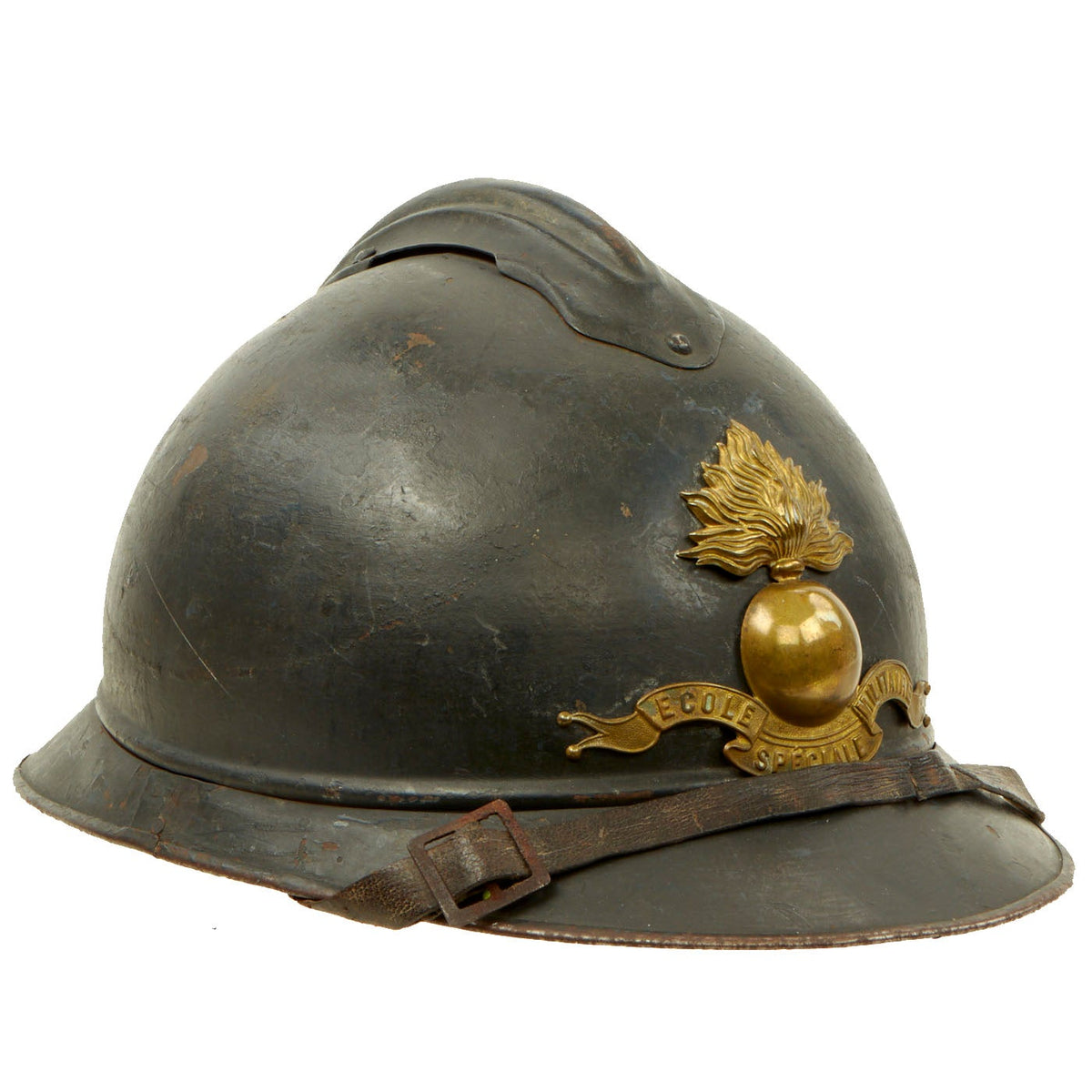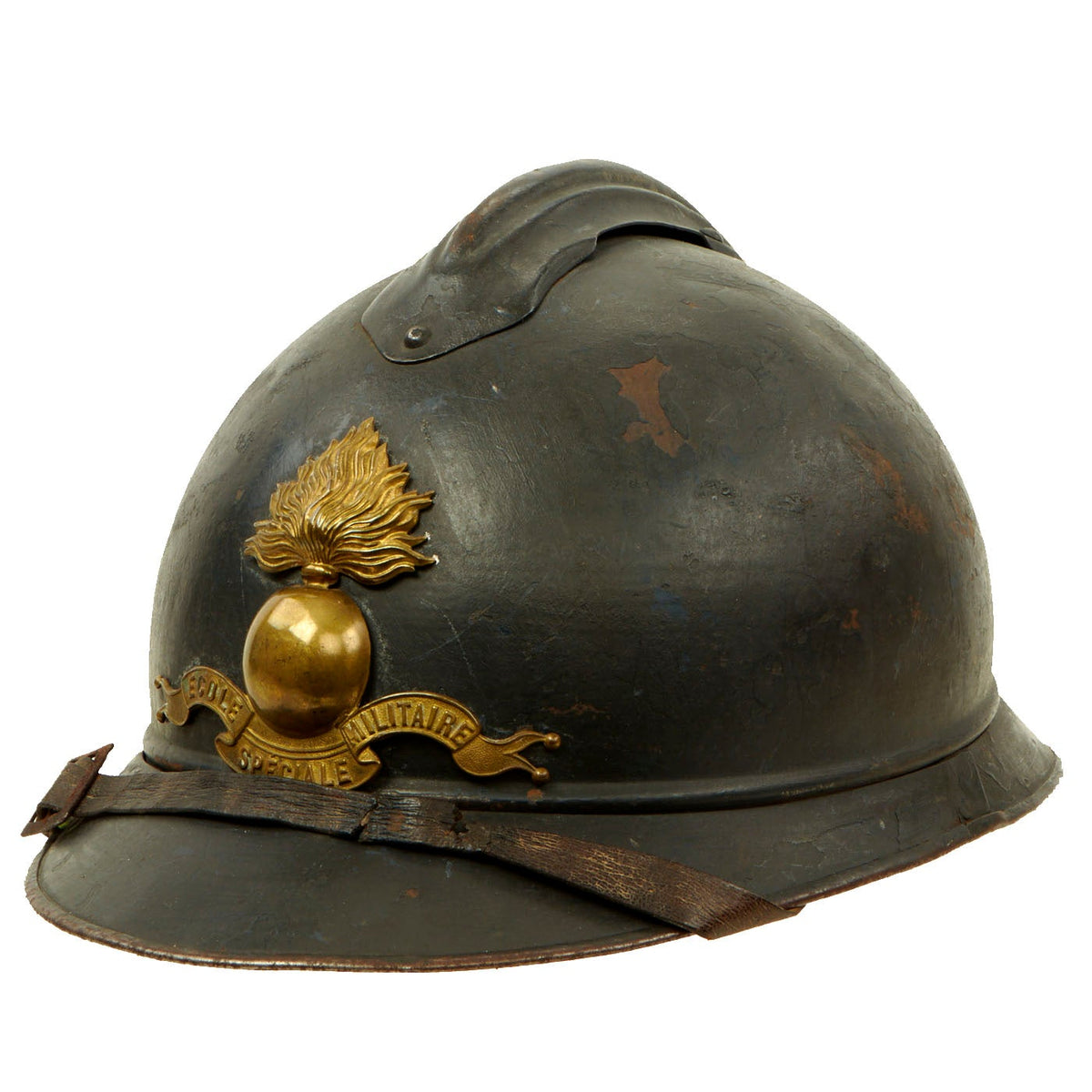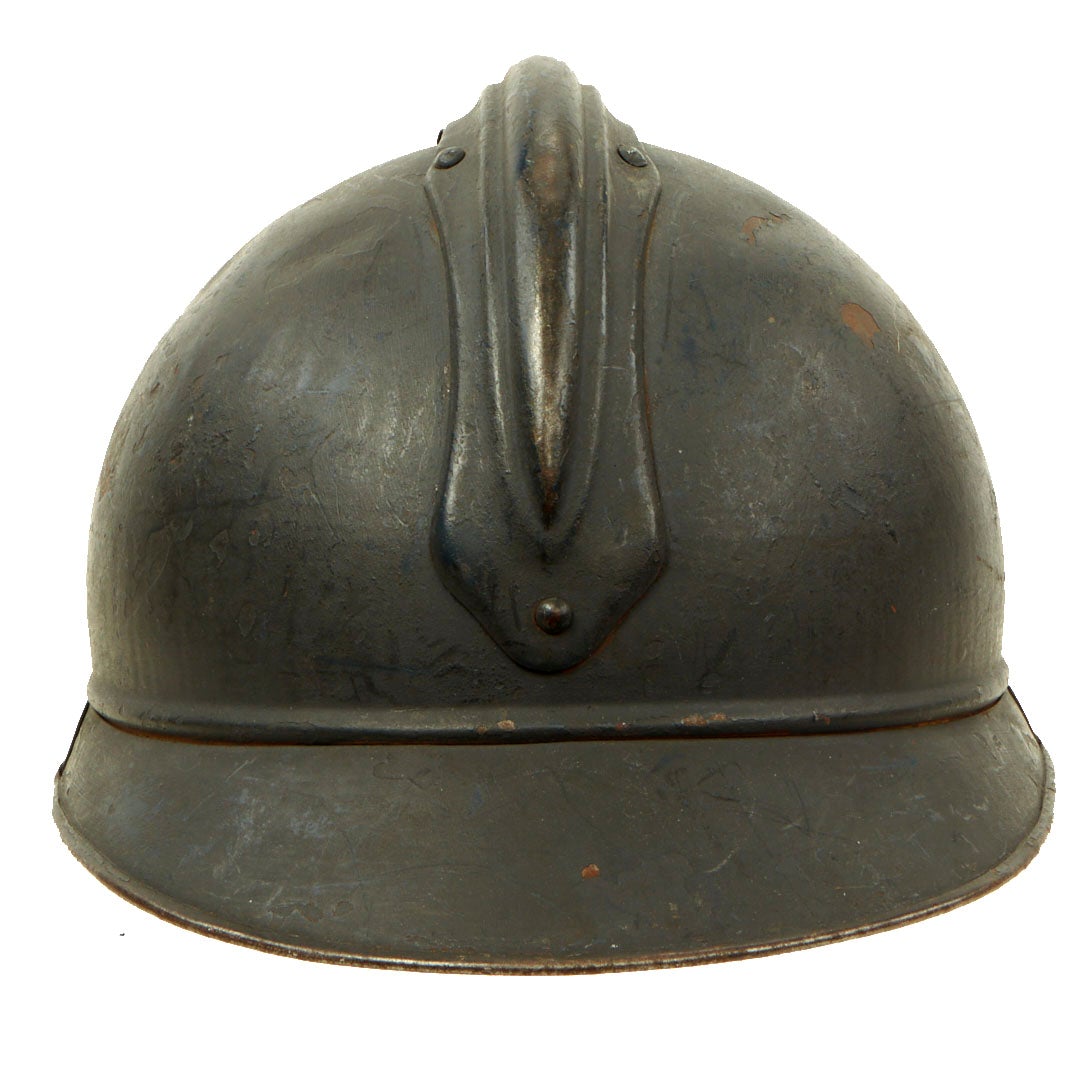Original French WWI M1915 Adrian Helmet with Ecole Speciale Militaire badge – Officer’s School – In Horizon Blue Original Items
$ 495,00 $ 148,50
Original Item: Only One Available. This is a nice example of a genuine World War I M1915 French Army “Adrian” steel helmet. The helmet retains the original “dark horizon blue” paint, along with the original French “Ecole Speciale Militaire” badge. The badge has the standard “Flaming bomb” with the words ECOLE SPÉCIALE MILITAIRE on a banner underneath it. The school is an Officer’s Candidate School and upon graduation all cadets receive their commission.
The liner size is approximately US 7 1/8 (57cm). Features a complete original leather liner in good condition, though it is worn and stained from age. The chin strap is present, but it is dry and cracked due to age and wear. Overall condition of the helmet is nice, though it does show its age. The shell shows some minor dings, scratches and paint wear consistent with age and long service. If you were looking for a nicely priced Adrian Helmet to fill out your WWI collection, this is a great chance!
History of the M15 Helmet
The M15 Adrian helmet (French: Casque Adrian) was a combat helmet issued to the French Army during World War I. It was the first standard helmet of the French Army and was designed when millions of French troops were engaged in trench warfare, and head wounds from the falling shrapnel generated by the new technique of indirect fire became a frequent cause of battlefield casualties. Introduced in 1915, it was the first modern steel helmet and it served as the basic helmet of many armies well into the 1930s. Initially issued to infantry soldiers, in modified form they were also issued to cavalry and tank crews. A subsequent version, the M26, was used during World War II.
École spéciale militaire de Saint-Cyr
The École spéciale militaire de Saint-Cyr (ESM, literally the “Special Military School of Saint-Cyr”) is a French military academy, and is often referred to as Saint-Cyr. It is located in Coëtquidan in Guer, Morbihan, Brittany. Its motto is Ils s’instruisent pour vaincre, literally meaning “They study to vanquish” or, more freely put, “Training for victory”. French cadet officers are called saint-cyriens or cyrards. France’s other most senior military education institute is the École de guerre (EdG) (School of Warfare), located in the École militaire complex, in Paris.
French students who enter Saint-Cyr as cadets are about 21 years old, and undergo three years of training. All ESM cadets graduate with a Master of Arts or a Master of Science and are commissioned officers.
The academy was founded in Fontainebleau in 1802 by Napoleon. It was moved in 1806 to the buildings of the former Maison Royale de Saint-Louis, in Saint-Cyr-l’École, west of Paris. During the Second World War, the cadets moved several times due to the German invasion. They eventually settled in 1945 in the Coetquidan military camp in Morbihan.
The École spéciale militaire de Saint-Cyr was created by order of Napoleon Bonaparte on 1 May 1802 (the Law of 11 Floréal an X according to the then-official revolutionary calendar), to replace the École Royale Militaire then located in Fontainebleau. Renamed the École Spéciale Impériale Militaire after Bonaparte was proclaimed emperor, it moved in 1808 to Saint-Cyr-l’École (Yvelines) in the castle of the former Maison royale de Saint-Louis, a school for girls of the French nobility disbanded at the time of the Revolution.
The school trained a large number of young officers and generals who served during the Napoleonic Wars, and later Napoleon III created the Prince Imperial division for family members, It remained stationed in Saint-Cyr-l’École after Napoleon’s deposition and through all regime changes until 1940. After the defeat of the French Army against Germany in 1940, the school moved to the free zone, in the south of France, in Aix-en-Provence. After the invasion of the free zone by the Germans in 1942, the school was disbanded, but French cadet officer training went on, part in Cherchell (Algeria, then Free French territory) and part in the United Kingdom (Cadets de la France Libre) under General de Gaulle’s command.
At the Libération of France in 1944, the school was reunited under the command of General de Lattre de Tassigny and settled in the somewhat remote and isolated military camp of Coëtquidan, Morbihan, because the “vieux bahut” (old school) had been severely damaged by an Allied bombing during the Libération campaign.
Saint-Cyr has remained there to this day. A reform in 1961 split the school into two entities: the current École Spéciale Militaire de Saint-Cyr (ESM), devoted to the training of direct-recruitment officers, recruited through an annual national competitive exam, and the École Militaire Interarmes (EMIA), cadets from internal recruitment (selected from non-commissioned officer (NCO) ranks and reserve officer ranks) and added a third entity, the École Militaire du Corps Technique et Administratif (EMCTA), devoted to the formation of administrative specialist officers and generals. The school admitted its first female cadets in 1983 and underwent a minor reform in 2002 devised to broaden the diversity of its recruitment.
Since 1802, 65,000 Saint-Cyriens have been trained, along with 2,000 international cadets. Of the French graduates 9,639 died on the field of battle. Alumni also count 11 Maréchaux de France, three French heads of state, two flying aces, six members of the Académie Française, and one Blessed of the Catholic Church.
The school has links with the Royal Military College of Canada, United States Military Academy (West Point), and the Royal Military Academy Sandhurst in Britain, including student exchanges.
Fast Shipping with Professional Packaging
Thanks to our longstanding association with UPS FedEx DHL, and other major international carriers, we are able to provide a range of shipping options. Our warehouse staff is expertly trained and will wrap your products according to our exact and precise specifications. Prior to shipping, your goods will be thoroughly examined and securely secured. We ship to thousands clients each day across multiple countries. This shows how we're dedicated to be the largest retailer on the internet. Warehouses and distribution centres can be located throughout Europe as well as the USA.
Note: Orders with more than one item will be assigned a processing date depending on the item.
Before shipping before shipping, we'll conduct a thorough inspection of the items you have ordered. Today, the majority of orders will be delivered within 48 hours. The delivery time will be between 3-7 days.
Returns
The stock is dynamic and we cannot completely manage it because multiple stakeholders are involved, including our factory and warehouse. So the actual stock may alter at any time. It's possible that you may not receive your order once the order has been made.
Our policy is valid for a period of 30 days. If you don't receive the product within 30 days, we are not able to issue a refund or an exchange.
You can only return an item if it is unused and in the same state as the day you received it. You must have the item in its original packaging.
Related products
Uncategorized
Uncategorized
Uncategorized
Uncategorized
Uncategorized
Uncategorized
Uncategorized
Uncategorized
Uncategorized
Band of Brothers ORIGINAL GERMAN WWII Le. F.H. 18 10.5cm ARTILLERY PIECE Original Items
Uncategorized
Uncategorized
Uncategorized
Uncategorized
Armoured Fighting Vehicles of the World: AFVs of World War One (Hardcover Book) New Made Items
Uncategorized
Uncategorized
Uncategorized
Uncategorized
Uncategorized
Uncategorized
Angolan Rebel 1970s era 60mm Inert Display Mortar from Angolan Civil War Original Items












































































